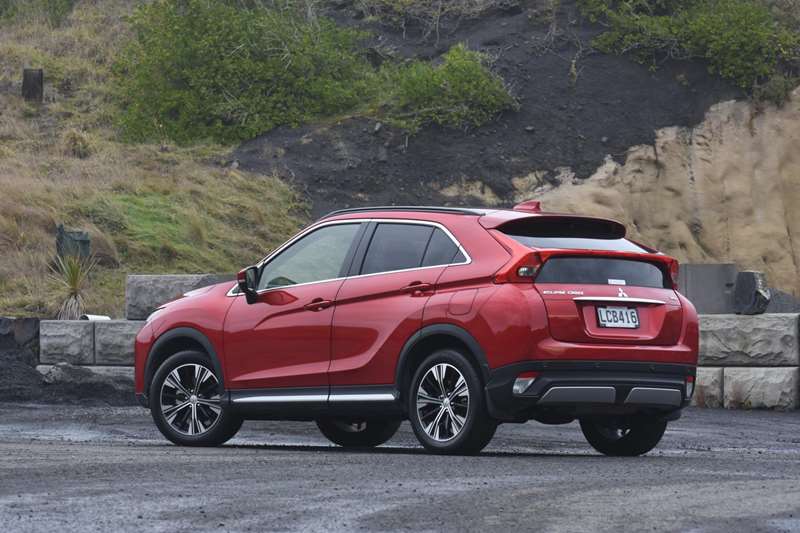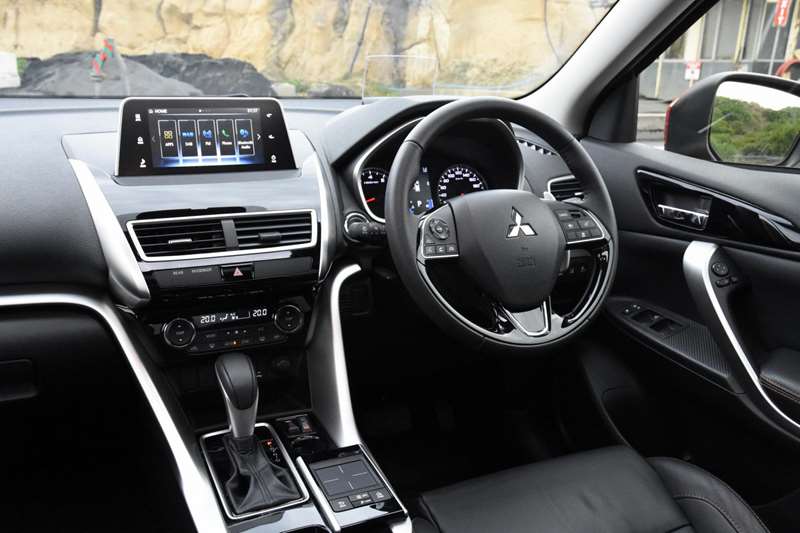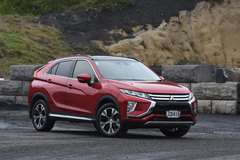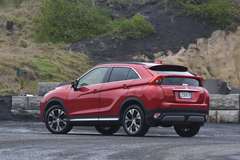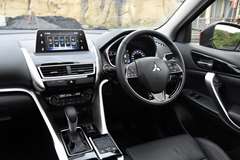| Price: | 45590 |
|---|---|
| Engine: | 1499cc four-cylinder turbo petrol, maximum power 112kW@5500rpm, maximum torque 254Nm@2000-3500rpm |
| Transmission: | Eight-stage CVT, front-drive |
| Brakes and stability systems: | Front and rear disc brakes, ABS, EBD, ASC |
| Safety: | Five-star NCAP |
| Wheels and tyres: | Alloy wheels, 225/55 R18 tyres |
| Fuel and economy: | 7.3 litres per 100km on standard cycle, capacity 63 litres |
| Emissions: | 165g of CO2/km |
| Dimensions: | Length 4405, width 1805, height 1685 |
Rating:
Overview
David Thomson gets behind the wheel of the Eclipse Cross, Mitsubishi's "best handling SUV'' to put it through its paces.
Rocketing interest in SUVs at the expense of conventional passenger cars has been a recurring theme in Drivesouth over the past couple of years. This trend is aptly illustrated by the addition of the Eclipse Cross to Mitsubishi's range.
This recent arrival to our shores slots into a Mitsubishi SUV segment that also comprises the ASX, Outlander and Pajero. That Mitsubishi now has just two conventional cars in its range _ the Mirage and Lancer _ against four SUVs speaks volumes for the latter's appeal in the Kiwi market.
It's not immediately clear where the Eclipse Cross sits in Mitsubishi's SUV hierarchy, other than somewhere alongside the Outlander and ASX. All three are spawned off the same underlying platform, and share an identical wheelbase.
Perhaps a clue to the Eclipse Cross's place comes not in its size, but its relatively modest 175mm of ground clearance (the Outlander and ASX muster 190mm and 205mm respectively). And a further hint is added by Mitsubishi's claim that it is "our best handling SUV''.
Presumably that means it is up with the latest in SUV play in being a heavily on-road focused machine, delivering better manners for everyday motoring at the expense of off-road abilities that few customers really require.
Important for many in Otago, the security of four-wheel-drive is still there in two models in the Eclipse Cross range, the $43,690 XLS 4WD and flagship $47,590 VRX. But front-wheel-drive versions are also on offer, currently priced at a special offer list price of $34,990 for the XLS 2WD, and $45,590 for the VRX 2WD. It was the latter that came Drivesouth's way for appraisal.
All Eclipse Cross vehicles feature turbocharged 1.5-litre petrol power. Happy to run on a diet of 91 octane, the Eclipse Cross's motor matches the older 2.0-litre petrol units of the ASX and Outlander for power (110kW) and blitzes them for torque, mustering 254Nm from just 2000rpm. On paper at least the smaller engine, which drives the wheels through an eight-stage CVT transmission, is more economical too, though matching the test car's official 7.3litres/100km standard cycle economy return on test proved a struggle.
Equipment levels are reasonable from entry-level, with 18-inch alloys, roof rails, LED running lights, auto headlights and rain-sensing wipers on the outside. The XLS 2WD also provides keyless entry and push-button start, an electronic park brake, cruise control, lane departure warning, and forward collision mitigation (automated braking). Its infotainment system is centred on a seven-inch centre touchscreen mounted high on the dash. The system is Apple CarPlay and Android Auto compatible, with Bluetooth and double USB connectivity, and a six-speaker sound system.
The VRX, as tested, has a swag of extra equipment including leather trim, heated and power-operated front seats, a double sunroof, dual zone climate control and full LED headlights. It also features a safety array comprising active radar cruise control, blind spot and rear cross traffic alert systems, a surround view camera, parking sensors, and a head up display.
Style-wise the Eclipse Cross features a bold rendering of the usual Mitsubishi nose and a distinctive vertical-split rear window and angular light clusters at the rear. Mounted along the sharp side creasing, the door handles are unusual in that they angle down slightly.
One feature that's easy to miss is the clever wrapping of the exterior door skins around the door sills. This means the sills stay clean and dry, so your trousers don't get dirty if you brush against them getting in or out of the vehicle.
The cabin itself is neatly styled, with soft touch-textured upper surfaces, and gloss plastic and matt silvered plastic highlighting. The trim then moves into harder, lighter plastics below waist level.
Packaging flexibility is provided by mounting the second-row seats on rails to provide fore-after adjustment. With these seats fully back there is ample rear legroom, but a fairly tight 374 litres of luggage capacity. This extends to the maximum 653 litres with the rear seats folded forward.
A space-saver spare under the boot floor is acceptable given the vehicle's on-road focus, and there's a handy load cover for the boot. Split 60:40, the rear seats include a fold-down centre armrest. But there are no directable rear vents, nor are there rear USB plug-ins.
The front seats are comfortable and supportive. Forward visibility is good and the sunroof brings plenty of light into the cabin. The rear three-quarter and full rear view is somewhat compromised by the car's relatively high glass line and split rear glass. However, these limitations are largely overcome on the VRX by the surround view camera, parking sensors, blind spot monitoring and rear cross traffic alert systems.
Cabin storage options are plentiful, and include wide door bins, dual cup holders between front seats, a tray for phone and keys forward of the gearshift, a deep, lidded centre bin which also doubles as an armrest, and a shelved glovebox.
The switchgear is a predominantly well located and easy to use, but the positioning of the trip computer menu buttons to the right of the steering column is a fiddle. So too, at least for non iPhone users, is the centre-console touchpad for navigating the centre touchscreen, However, if you do have an Apple rather than Android device, take note that the touchpad works with Apple CarPlay phone projection. That smartphone integration is essential for satellite navigation, as the car itself has no sat nav of its own.
On test, the Eclipse Cross VRX fulfilled its brief as an easygoing and quite car-like machine.
Its engine impressed for delivering a decent spread of power and torque, and for its smooth nature at low to moderate revs. Driving around town at light throttle openings the operation of the CVT was barely distinguishable from that of a conventional automatic. The same was true when cruising on the open road. Some CVT rev flare is apparent when working the engine harder (say for snappy overtaking).
Pressing the test car down winding tarmac roads was an interesting exercise. There is sufficient mechanical vim to produce a little wheelspin and a hint of torque steer on tighter corners, but while the Eclipse Cross is stable and well enough balanced, it isn't the style of vehicle that invites hard-edged driving.
Rather, it impresses for combining an underlying firmness to its ride with an ability to soak up nasty surface imperfections without becoming uncomfortable or unsettled. Road noise is also well contained, adding to the Eclipse Cross's strong refinement credentials.
As an interesting aside, the Eclipse Cross was the last Mitsubishi passenger vehicle to be developed before the company became part of a wider automotive group which includes Renault and Nissan. Shared platforms will be the way of the future for this group, so as well as being a fresh new arrival, the Eclipse Cross is potentially the last of a kind.

